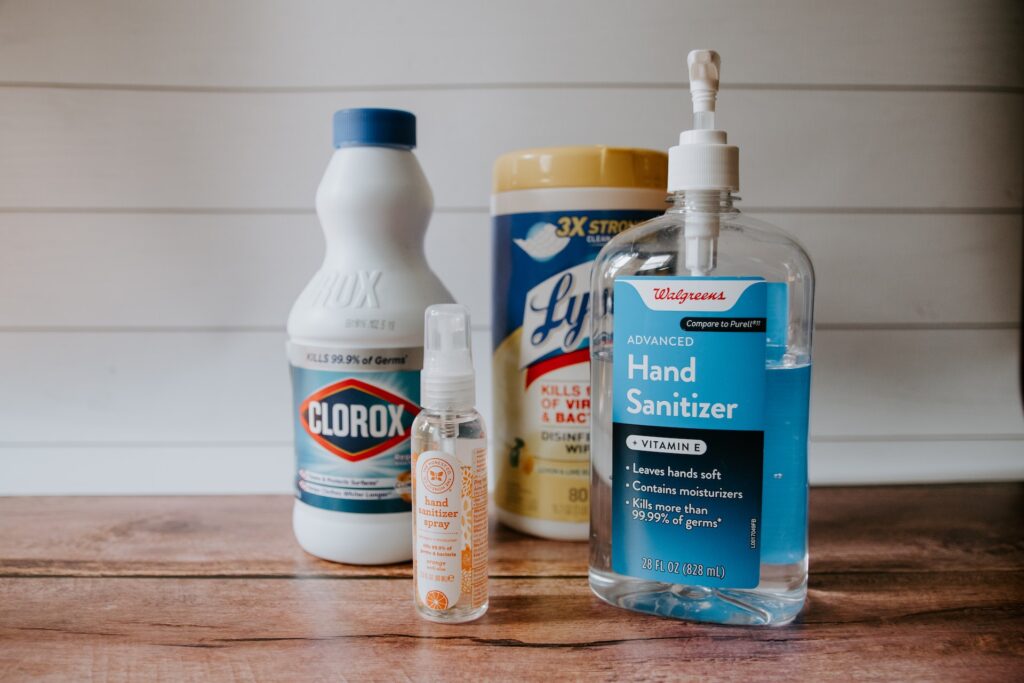Cleaning and Disinfecting
Cleaning and Disinfecting to Prevent COVID-19 Transmission
COVID-19 is mainly transmitted via aerosols which are exhaled by infected people, and can float and linger in the air for hours. Cleaning indoor air with proper Ventilation and filtration to remove airborne particles and wearing well-fitted, high-quality Masks is essential to prevent transmission through this mechanism[1]. There is also evidence of transmission through contact of particles with the eyes, and eye protection is recommended [2]. Earlier in the pandemic it was widely believed that transmission was limited to the effect of larger droplets resulting from sneezing and coughing, as well as from talking and singing. According to this view these larger particles were either inhaled in close proximity to others, i.e. within a 6’ radius, or they were depositing virus onto the mucous membranes of the eyes, nose, and mouth, or they were falling onto surfaces from where it could be transferred to the hands and then to the face by touch. Currently, the risk from transmission through deposits on surfaces is considered much less likely than airborne transmission in areas where airborne protection is not widely implemented. Nevertheless, there continues to be evidence for such transmission in places where it can be traced because there is better control of the virus.[3][4] The likelihood of surface transmission, also called fomite transmission, may vary among variants and there is new evidence suggesting that Omicron persists much longer on surfaces.[5] There is also evidence for food borne transmission including widespread early gastrointestinal symptoms[6] and early warning sewage detection[7]. The extent to which viral particles are re-aerosolized from surfaces, including from shaking fabrics and masks, is not known, but this should be avoided.
Even if the likelihood of surface transmission is significantly lower than airborne transmission, while keeping the primary focus on cleaning and filtering indoor air, regular cleaning and disinfecting of high-touch surfaces such as doorknobs, light switches, elevator buttons, etc., helps to prevent disease spread in general, and it is recommended to continue this practice. Surface disinfection is particularly important in hospitals and in locations where infected individuals are isolating. Where airborne transmission precautions are being observed, increased attention to preventing surface transmission is justified. Washing and properly cooking fresh food, and avoiding contamination during preparation, e.g. not preparing vegetables with hands, utensils, or on surfaces, that have not been washed after handling raw animal or other products, helps to prevent all food-borne disease transmission. Attention should also be made to avoiding contamination between preparation and consumption (see Everyday Life).

Cleaning physically removes dust, dirt and other impurities from surfaces, and reduces the amount of germs, such as bacteria and viruses, in places where people live, thereby reducing the risk of spreading infection. Some forms of cleaning also neutralize germs by killing bacteria or inactivating viruses. Otherwise, this is done by disinfection after cleaning to further reduce the risk.
The virus causing COVID-19, can be neutralized by soap, alcohol or chlorine bleach or other products[8] such as commercial sanitizing wipes. These agents dissolve dirt and fats by breaking down the virus into its parts and making them water soluble. For a full effect, it is essential to follow the package instructions about how to use these products and how long to let them dry or to wait prior to rinsing.
Time also kills viral particles.[9][10][11] Over a period of hours, small amounts of viral particles on cardboard become inactive, and over a period of a few days, they become inactive on hard plastic and metal surfaces. The effect of time depends strongly on temperature. Cold temperatures increase the time so outdoor cold winter conditions, refrigeration or freezing leads to long persistence times. Heating reduces the amount of time, so that disinfection is possible at higher temperatures. For example, heating for 12 minutes at 75°C (170°F) is a robust way to disinfect those lightly contaminated objects that can safely be exposed to heat (wear a mask or stay away during this process).
For high density deposits or large areas, the reliability of inactivation with time decreases and chemical disinfection is highly recommended.
In general there are two types of surfaces that need to be cleaned and they require different protocols. Soft, porous materials include carpeting, rugs, towels, clothing, sofas, chairs, bedding, soft fabric toys (i.e., stuffed animals), etc. Hard non-porous surfaces include stainless steel, floors, kitchen surfaces, countertops, tables and chairs, sinks, toilets, railings, light switch plates, doorknobs, metal/plastic toys, computer keyboards, remote controls, and recreation equipment.



Supplies
- Waterproof gloves such as latex, nitrile or dishwashing gloves
- Soap/detergent, warm water, clean towels, leak-proof plastic trash bags
- Disposable gowns for extensive cleaning related tasks including taking out industrial trash
- High quality face mask
- Goggles (both to prevent contaminated dust particles entering them and to prevent reactions to cleaning and disinfecting solvents)
- Disinfectants
General Guidelines for Cleaning
- Wear masks, goggles, gloves and, where necessary, gowns throughout the cleaning process, including when discarding trash and vacuum cleaner refuse
- Discard rather than clean or disinfect highly contaminated items
- Immediately throw away all disposable cleaning items
- If gloves are not available, wash hands frequently including after emptying waste baskets and touching contaminated materials, including tissues and similar waste.
- Wash your hands thoroughly with soap and water for at least 20 seconds or use an alcohol-based hand sanitizer that contains at least 60% alcohol
- When replacing gloves or completing the job, remove gloves by pulling them off inside-out, and place in a trash bag and discard
- Wash hands after removing gloves when completing the job
Clothing and other Soft, Porous Materials that Can Be Laundered
- Place materials in a sealed plastic bag until laundering, do not shake, and discard safely after use
- Read manufacturer’s laundering instructions for any temperature or product restrictions
- Launder using hot water and a detergent, preferably containing color-safe bleach
- Dry on high heat
Soft, Porous Materials that Can not Be Laundered (Carpets, Couches, Other Porous Surfaces)
- Vacuum to keep dust from spreading into the air
- Spot-clean spills of bodily fluid promptly following safe procedures
- Deep clean carpets while avoiding splashing as much as possible
- Use steam cleaners to clean carpets and other porous surfaces as needed
Hard, Non-Porous Surfaces
- Follow labeled instructions on all containers
- Clean surface first with soap and water to remove all visible debris and stains
- Rinse surface with clean water and wipe with clean towel
- Apply the disinfectant. To effectively kill the virus, make sure the surface stays wet with the disinfectant for at least 10 minutes before wiping with a clean towel. If an EPA registered disinfectant is not available, a 2% chlorine bleach solution can be made and used. Use alcohol based disinfectants with care as they tend to evaporate quickly and may not fully disinfect if instructions are not followed
- Rinse with water and allow surface to air dry. Rinsing following use of a disinfectant is especially important in food preparation areas
- Mop heads should be cleaned with soap and hot water, sanitized with an EPA-registered disinfectant or bleach solution, and allowed to dry. Consider using single-use, disposable mop heads or cloths as an alternative
https://www.thelancet.com/journals/lancet/article/PIIS0140-6736(21)00869-2/fulltext
https://www.thelancet.com/journals/lanmic/article/PIIS2666-5247(21)00040-9/fulltext
https://www.biorxiv.org/content/10.1101/2022.01.18.476607v1.full
https://www.gastrojournal.org/article/S0016-5085(20)30471-6/fulltext
https://www.cdc.gov/healthywater/surveillance/wastewater-surveillance/wastewater-surveillance.html
https://www.epa.gov/pesticideregistration/list-n-disinfectants-use-against-sars-cov-2
https://www.sciencedirect.com/science/article/pii/S0195670120300463
https://www.thelancet.com/journals/lanmic/article/PIIS2666-5247%2820%2930003-3/fulltext

